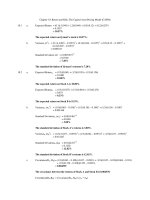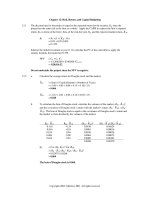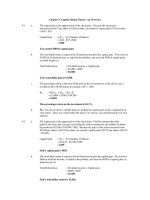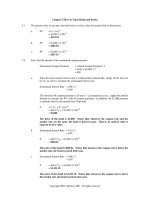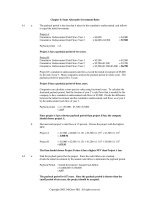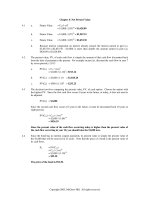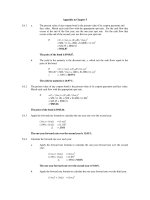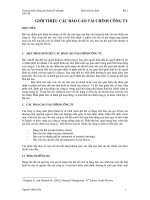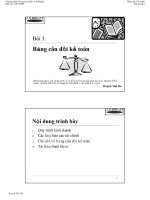Tài liệu Tài chính doanh nghiệp ( Bài tập)_ Chapter 6 pptx
Bạn đang xem bản rút gọn của tài liệu. Xem và tải ngay bản đầy đủ của tài liệu tại đây (145.58 KB, 16 trang )
Chapter 6: Some Alternative Investment Rules
6.1 a. The payback period is the time that it takes for the cumulative undiscounted cash inflows
to equal the initial investment.
Project A:
Cumulative Undiscounted Cash Flows Year 1 = $4,000 = $4,000
Cumulative Undiscounted Cash Flows Year 2 = $4,000 +$3,500 = $7,500
Payback period = 2
Project A has a payback period of two years.
Project B:
Cumulative Undiscounted Cash Flows Year 1 = $2,500 = $2,500
Cumulative Undiscounted Cash Flows Year 2 = $2,500+$1,200 = $3,700
Cumulative Undiscounted Cash Flows Year 3 = $2,500+$1,200+$3,000 = $6,700
Project B’s cumulative undiscounted cash flows exceed the initial investment of $5,000
by the end of year 3. Many companies analyze the payback period in whole years. The
payback period for project B is 3 years.
Project B has a payback period of three years.
Companies can calculate a more precise value using fractional years. To calculate the
fractional payback period, find the fraction of year 3’s cash flows that is needed for the
company to have cumulative undiscounted cash flows of $5,000. Divide the difference
between the initial investment and the cumulative undiscounted cash flows as of year 2
by the undiscounted cash flow of year 3.
Payback period = 2 + ($5,000 - $3,700) / $3,000
= 2.43
Since project A has a shorter payback period than project B has, the company
should choose project A.
b. Discount each project’s cash flows at 15 percent. Choose the project with the highest
NPV.
Project A = -$7,500 + $4,000 / (1.15) + $3,500 / (1.15)
2
+ $1,500 / (1.15)
3
= -$388.96
Project B = -$5,000 + $2,500 / (1.15) + $1,200 / (1.15)
2
+ $3,000 / (1.15)
3
= $53.83
The firm should choose Project B since it has a higher NPV than Project A has.
6.2 a. Find the payback period for the project. Since the cash inflows are constant,
divide the initial investment by the annual cash inflow to determine the payback period.
Payback Period = Initial Investment / Annual Cash Inflow
= $1,000,000 / $150,000
= 6.67
The payback period is 6.67 years. Since the payback period is shorter than the
cutoff period of ten years, the project should be accepted.
Copyright 2003, McGraw-Hill. All rights reserved.
b. Find the number of years needed for the discounted cash inflows to equal the initial
investment of $1 million. Apply the annuity formula, discounted at 10 percent, to find
the approximate discounted payback period. The approximate discounted payback period
is the year in which the PV of the initial investment is surpassed.
Since the discounted payback period will always be greater than the
undiscounted payback period when there are positive cash inflows, start the
approximation at year 7.
Cumulative Discounted Cash Flows Year 7 = $150,000 A
7
0.1
= $730,262.82
Cumulative Discounted Cash Flows Year 8 = $150,000 A
8
0.1
= $800,238.93
Cumulative Discounted Cash Flows Year 9 = $150,000 A
9
0.1
= $863,853.57
Cumulative Discounted Cash Flows Year 10 = $150,000 A
10
0.1
= $921,685.07
Cumulative Discounted Cash Flows Year 11 = $150,000 A
11
0.1
= $974,259.15
Cumulative Discounted Cash Flows Year 12 = $150,000 A
12
0.1
= $1,022,053.77
The cumulative discounted cash flows exceed the initial investment of $1,000,000 by the
end of year 12. Many companies analyze the payback period in whole years. The
payback period for the project is 12 years.
The discounted payback period is 12 years.
c. Apply the perpetuity formula, discounted at 10 percent, to calculate the PV of the annual
cash inflows.
NPV = -$1,000,000 + $150,000 / 0.1
= $500,000
The NPV of the project is $500,000.
6.3 a. The average accounting return is the average project earnings after taxes, divided by the
average book value, or average net investment, of the machine during its life. The book
value of the machine is the gross investment minus the accumulated depreciation.
Average Book Value = (Book Value
0
+ Book Value
1
+ Book Value
2
+ Book Value
3
+ Book Value
4
+ Book Value
5
) / (Economic Life)
= ($16,000 + $12,000 + $8,000 + $4,000 + $0) / (5 years)
= $8,000
Average Project Earnings = $4,500
Divide the average project earnings by the average book value of the machine to calculate
the average accounting return.
Average Accounting Return = Average Project Earnings / Average Book Value
= $4,500 / $8,000
= 0.5625
= 56.25%
The average accounting return is 56.25%.
Copyright 2003, McGraw-Hill. All rights reserved.
b. 1. The average accounting return uses accounting data rather than net cash flows.
2. The average accounting return uses an arbitrary firm standard as the decision
rule. The firm standard is arbitrary because it does not necessarily relate to a
market rate of return.
3. The average accounting return does not consider the timing of cash flows.
Hence, it does not consider the time value of money.
6.4 Determine the average book value of the investment. The book value is the gross investment
minus accumulated depreciation.
Purchase Year 1 Year 2 Year 3 Year 4 Year 0
Gross Investment $2,000,000 $2,000,000 $2,000,000 $2,000,000 $2,000,000 $2,000,000
Less: Accumulated
Depreciation
0
400,000
800,000
1,200,000
1,600,000
2,000,000
Net Investment $2,000,000 $1,600,000 $1,200,000 $800,000 $400,000 $0
Average Book Value = ($2,000,000 + $1,600,000 + $1,200,000 + $800,000
+ $400,000 + $0) / (6)
= $1,000,000
Next, calculate average annual net income.
Net Income Year 1 = $100,000
Net Income Year 2 = $100,000 × (1.07) = $107,000
Net Income Year 3 = $100,000 × (1.07)
2
= $114,490
Net Income Year 4 = $100,000 × (1.07)
3
= $122,504
Net Income Year 5 = $100,000 × (1.07)
4
= $131,080
Average Net Income = ($100,000+$107,000+$114,490+$122,504+$131,080) / 5
= $115,015
The average accounting return is the average net income divided by the average book value.
Average Accounting Return = Average Net Income / Average Book Value
= $115,015 / $1,000,000
= 0.115
= 11.5%
Since the machine’s average accounting return, 11.5%, is below the company’s cutoff of
20%, the machine should not be purchased.
6.5 First determine the average book value of the project. The book value is the gross investment
minus accumulated depreciation.
Purchase Date Year 1 Year 2 Year 3
Gross Investment $8,000 $8,000 $8,000 $8,000
Less: Accumulated
Depreciation
0
4,000
6,500
8,000
Net Investment $8,000 $4,000 $1,500 $0
Average Book Value = ($8,000 + $4,000 + $1,500 + $0) / (4 years)
= $3,375
Copyright 2003, McGraw-Hill. All rights reserved.
Remember to use the after-tax average net income when calculating the average accounting return.
Average After-tax Net Income = (1 – T
c
) Annual Pre-tax Net Income
= (1 – 0.25) $2,000
= $1,500
The average accounting return is the average after-tax net income divided by the average book
value.
Average Accounting Return = $1,500 / $3,375
= 0.44
= 44%
The average accounting return of the machine is 44%.
6.6 The internal rate of return is the discount rate at which the NPV of the project’s cash flows equals
zero. Set the project’s cash flows, discounted at the internal rate of return (IRR), equal to zero.
Solve for the IRR.
IRR(Project A) = C
0
+ C
1
/ (1+IRR) + C
2
/ (1+IRR)
2
0 = -$3,000 + $2,500 / (1+IRR) + $1,000 / (1+IRR)
2
IRR = 0.1289
IRR(Project B) = C
0
+ C
1
/ (1+IRR) + C
2
/ (1+IRR)
2
0 = -$6,000 + $5,000 / (1+IRR) + $1,000 / (1+IRR)
2
IRR = 0.1289
Note that since Project B’s cash flows are two times those of Project A, the IRR’s of both projects
are the same.
The IRR of both Project A and Project B is 12.89%.
6.7 a. The internal rate of return is the discount rate at which the NPV of the project’s cash
flows equal zero. Set the project’s cash flows, discounted at the internal rate of return
(IRR), equal to zero. Solve for the IRR.
IRR = C
0
+ C
1
/ (1+IRR) + C
2
/ (1+IRR)
2
+ C
3
/ (1+IRR)
3
0 = -$8,000 + $4,000 / (1+IRR) + $3,000 / (1+IRR)
2
+ $2,000 / (1+IRR)
3
IRR = 0.0693
The IRR is 6.93%.
b. No. An investing-type project is one with a negative initial cash outflow and positive
future cash inflows. One accepts a project when the IRR is greater than the discount rate.
Similarly, one rejects the project when the IRR is less than the discount rate. The project
should not be accepted because the IRR (6.93%) is less than the discount rate (8%).
Copyright 2003, McGraw-Hill. All rights reserved.
6.8 Set the project’s cash flows, discounted at the internal rate of return (IRR), equal to zero. Solve
for the IRR.
IRR(Project A) = C
0
+ C
1
/ (1+IRR) + C
2
/ (1+IRR)
2
+ C
3
/ (1+IRR)
3
0 = -$2,000 + $2,000 / (1+IRR) + $8,000 / (1+IRR)
2
+ $8,000 / (1+IRR)
3
IRR = 1.88
IRR(Project B) = C
0
+ C
1
/ (1+IRR) + C
2
/ (1+IRR)
2
+ C
3
/ (1+IRR)
3
0 = -$1,500 + $500 / (1+IRR) + $1,000 / (1+IRR)
2
+ $1,500 / (1+IRR)
3
IRR = 0.362
The IRR for Project A is 188% and the IRR for Project B is 36.2%.
6.9 a. Set the project’s cash flows, discounted at the internal rate of return (IRR), equal to zero.
Solve for the IRR.
IRR = C
0
+ C
1
/ (1+IRR) + C
2
/ (1+IRR)
2
+ C
3
/ (1+IRR)
3
+ C
4
/ (1+IRR)
4
0 = $5,000 - $2,500 / (1+IRR) - $2,000 / (1+IRR)
2
- $1,000 / (1+IRR)
3
- $1,000 / (1+IRR)
4
IRR = 0.1399
The IRR is 13.99%.
b. This problem differs from previous ones because the initial cash flow is positive and all
future cash flows are negative. In other words, this is a financing-type project while
previous projects were investing-type projects. For financing situations, accept the
project when the IRR is less than the discount rate. Reject the project when the IRR is
greater than the discount rate.
IRR = 13.99%
Discount Rate = 10%
IRR > Discount Rate
Reject the offer when the discount rate is less than the IRR.
c. IRR = 13.99%
Discount Rate = 20%
IRR < Discount Rate
Accept the offer when the discount rate is greater than the IRR.
d. Calculate the NPV when the discount rate is 10 percent.
NPV = $5,000 - $2,500 / (1.1) - $2,000 / (1.1)
2
- $1,000 / (1.1)
3
- $1,000 / (1.1)
4
= -$359.95
When the discount rate is 10 percent, the NPV of the offer is -$359.95. Reject the
offer.
Calculate the NPV when the discount rate is 20 percent.
NPV = $5,000 - $2,500 / (1.2) - $2,000 / (1.2)
2
- $1,000 / (1.2)
3
- $1,000 / (1.2)
4
= $466.82
Copyright 2003, McGraw-Hill. All rights reserved.
When the discount rate is 20 percent, the NPV of the offer is $466.82. Accept the
offer.
e. Yes, the decisions under the NPV rule are consistent with the choices made under
the IRR rule since the signs of the cash flows change only once.
6.10 a. Set the project’s cash flows, discounted at the internal rate of return (IRR), equal to zero.
Solve for the IRR.
IRR(Project A) = C
0
+ C
1
/ (1+IRR) + C
2
/ (1+IRR)
2
0 = -$5,000 + $3,500 / (1+IRR) + $3,500 / (1+IRR)
2
IRR = 0.2569
The IRR of project A is 25.69%.
IRR(Project B) = C
0
+ C
1
/ (1+IRR) + C
2
/ (1+IRR)
2
0 = -$100,000 + $65,000 / (1+IRR) + $65,000 / (1+IRR)
2
IRR = 0.1943
The IRR of project B is 19.43%.
b. Choose project A because it has a higher IRR than project B.
c. The difference in scale was ignored. Project B has a substantially larger initial
investment than project A has. Thus, the simple IRR calculation may not lead to the best
decision.
d. Calculate the incremental IRR. The incremental IRR is the IRR on the incremental
investment from choosing the larger project instead of the smaller project. The
incremental cash flows are the differences between the cash flows of project B and those
of project A. Always subtract the project with the smaller initial cash outflow from the
project with the larger initial cash outflow. In this way, the initial incremental cash flow
will be negative.
Year 0 Year 1 Year 2
Project B Cash Flows -$100,000 $65,000 $65,000
Project A Cash Flows -5,000 3,500 3,500
B – A -$95,000 $61,500 $61,500
Next, find the IRR of those incremental cash flows.
IRR(B – A) = C
0
+ C
1
/ (1+IRR) + C
2
/ (1+IRR)
2
0 = -$95,000 + $61,500 / (1+IRR) + $61,500 / (1+IRR)
2
IRR = 0.191
The incremental IRR is 19.1%.
e. For investing-type projects, accept the larger project when the incremental rate of return
is greater than the discount rate. Therefore, choose project B since the incremental IRR
(19.1%) is greater than the 15 percent discount rate.
Copyright 2003, McGraw-Hill. All rights reserved.
